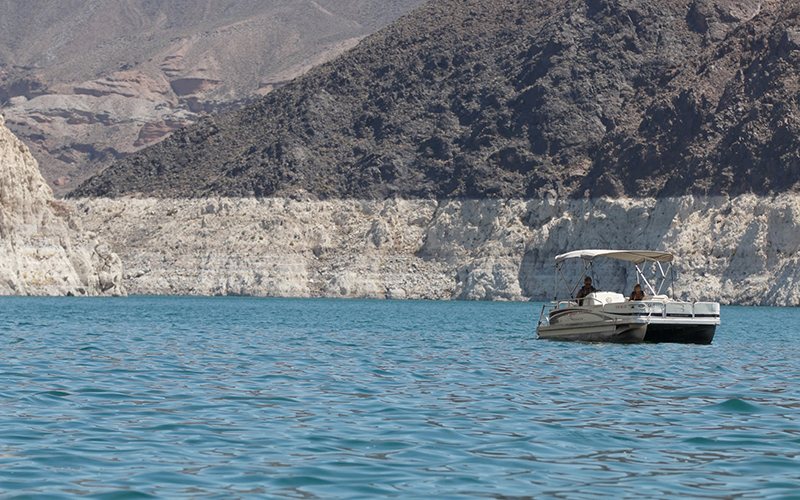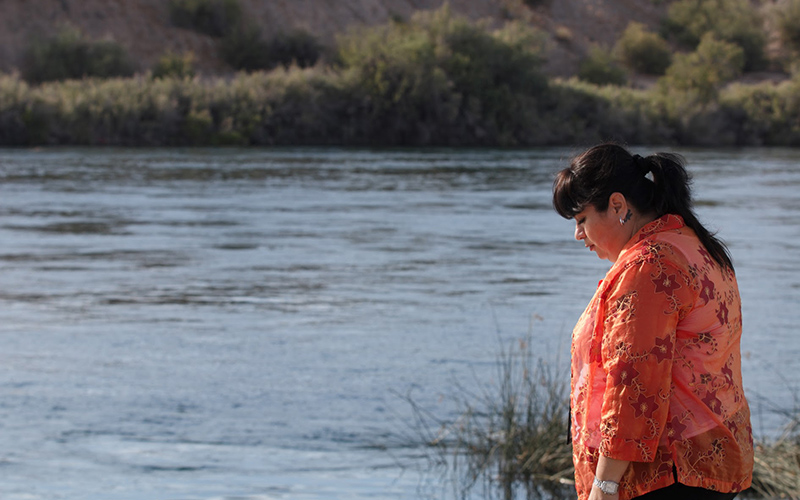
A “bathtub ring” of calcium deposits shows how nearly two decades of drought have lowered water levels in Lake Mead, a major Colorado River reservoir. (Photo by Alexis Kuhbander/Cronkite News)
GREELEY, Colo. – Reservoirs along the Colorado River are projected to be less than half full by summer’s end, potentially marking a historic low mark for the river system that supplies water to seven U.S. states and Mexico.
Forecasters with the U.S. Bureau of Reclamation expect the river’s reservoirs – Lakes Mead and Powell among them – to be at a combined 48 percent of capacity by the end of September. That would be one of the lowest points ever for the combined water storage.
Without significant rainfall this summer and fall and above-average snow next winter, the combined reservoir storage could dip to 44 percent of capacity by April 2019, according to the bureau’s models.
The previous low for total system storage came April 1, 2014, after the two driest consecutive years recorded in the vast watershed, when the river’s reservoirs were at 47 percent of capacity.
“We’re in uncharted territory for the system,” said Jeff Kightlinger, general manager of the Metropolitan Water District of Southern California, the water wholesaler for greater Los Angeles, which relies on the Colorado River for a portion of its supplies.
“Everything is new, and it’s all bleak. None of it is positive.”
The root cause is twofold: Low snowpack last winter is depleting reservoirs already sapped by nearly two decades of drought. And the river itself is over-allocated: More water exists on paper in the form of water rights than what exists in reality.
Lake Powell, the water-savings account for Colorado, Wyoming, New Mexico and Utah, is taking the brunt of this year’s dry weather, said Rick Clayton, a Bureau of Reclamation engineer in Salt Lake City.
“Lake Powell is not getting a very significant inflow, and we’re making a pretty large release,” he said.
Inflow to Powell, provided by the Colorado’s main channel and the San Juan River, is projected to be 39 percent of average. That places 2018 among the driest years on record for the river basin.
The river’s reservoirs have remained low for nearly the entirety of the 21st century so far, Clayton said.
“When a reservoir system is half full, (it) isn’t necessarily a reason to panic,” he said. “It is not uncommon for the Colorado River reservoir system to be nearly half empty, especially during the recent protracted drought we have been experiencing since 2001.”
Arizona, Colorado, Wyoming, Utah, New Mexico, Nevada, California and Mexico all claim some portion of the Colorado’s flow. The river provides water for about 40 million people in the Southwest and irrigates 1.7 million acres of farmland.
This story is part of Elemental: Covering Sustainability, a new multimedia collaboration between Cronkite News, Arizona PBS, KJZZ, KPCC, Rocky Mountain PBS and PBS SoCal.
Subscribe to Cronkite News on YouTube.
